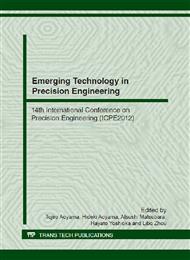[1]
Vollertsen, F.; Schulze Niehoff, H.; Hu, Z: State of the art in micro forming, International Journal of Machine Tools and Manufacture, Vol 46 (2006) p.1172–1179
DOI: 10.1016/j.ijmachtools.2006.01.033
Google Scholar
[2]
Vollertsen, F.; Hu, Z.: Determination of size-dependent friction functions in sheet metal forming with the respect to the distribution of the contact pressure. Annals of the WGP, Production Engineering Vol: 2 (2008) pp.345-350
DOI: 10.1007/s11740-008-0130-4
Google Scholar
[3]
Brinksmeier, E.; Riemer, O.; Twardy, S.: Tribological behaviour of micro structured surfaces for micro forming tools, International Journal of Machine Tools and Manufacture, Vol 50 (2010) pp.425-430
DOI: 10.1016/j.ijmachtools.2009.11.006
Google Scholar
[4]
Brinksmeier, E.; Gläbe, R.; Riemer, O.; Twardy, S.: Potentials of precision machining processes for the manufacture of micro forming molds. Microsystem Technologies, Springer, Vol. 14/12 (2008) p.1983–(1987)
DOI: 10.1007/s00542-008-0656-6
Google Scholar
[5]
Suh, N.P.; Mosleh, M.: The Minimum Coefficient of Friction: What Is It?, Annals of the CIRP, Vol 43, Issue 1 (1994) pp.491-495
DOI: 10.1016/s0007-8506(07)62260-4
Google Scholar
[6]
Jacobson, S.; Hogmark, S.: Surface modifications in tribological contacts, Wear, Issue 266 (2009) pp.370-378
DOI: 10.1016/j.wear.2008.04.035
Google Scholar
[7]
Brinksmeier, E.; Riemer, O.; Twardy, S.: Surface Analysis of Micro Ball End Milled Cold Work Tool Steels. Proceedings of the 2nd Nanoman, International Conference on Nanomanufacturing, Tianjin (2010) # 173
Google Scholar
[8]
Aramcharoen, A.; Mativenga, P.T.: Size effect and tool geometry in micro milling of tool steel. Precision Engineering, Vol. 33 (2009) pp.402-407
DOI: 10.1016/j.precisioneng.2008.11.002
Google Scholar
[9]
Jin, S.; Graebner, J.E.; Kammlott, G.W.; Tiefel, T.H.; Kosinski, S.G.; Chen, L.H.: Massive Thinning of Diamond Films by Diffusion Process. Applied Physics Letters Vol. 60 No.16 (1992) pp.1948-1950
DOI: 10.1063/1.107133
Google Scholar
[10]
Wilks, E.M; Wilks, J.: Properties and applications of diamond, Oxford: Butterworth-Heinemann Ltd., Oxford, (1991)
Google Scholar
[11]
Paul, E.; Evans, C. J.; Mangamelli, A.; McGlauflin, M.L.; Polvani, R.S.; Chemical Aspects of Tool Wear in Single Point Diamond Turning Precision Engineering, Vol: 18 (1996) pp.4-19
DOI: 10.1016/0141-6359(95)00019-4
Google Scholar
[12]
Brinksmeier, E.; Klopfstein, M.J.; Riemer, O.: Removal of Diamond by Solid Metals. Proceedings of the 2nd Nanoman, International Conference on Nanomanufacturing, Tianjin (2010) # 186
Google Scholar
[13]
Chen, Y.; Zhang, L.C.: Polishing of Polycrystalline Diamond by the Technique of Dynamic Friction, Part 4: International Journal of Machine Tools and Manufacture, Vol: 49 No: 3-4 (2009) pp.309-314
DOI: 10.1016/j.ijmachtools.2008.10.010
Google Scholar


